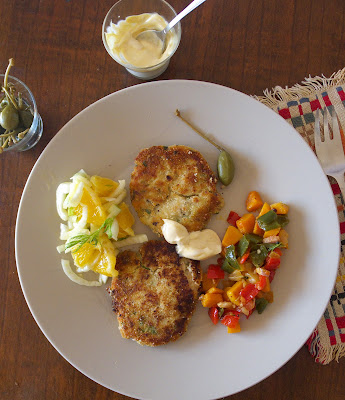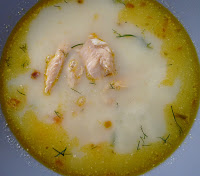 |
| Smoked trout served whole with a selection of classic accompaniments, from top left, capers, dill, horseradish, cream cheese, Dijon mustard and scallions. |
A pair of bronzed smoked trout landed in my kitchen this week. My son Ben, returning from a hiking trip in the Sierra Nevada, brought them from Riofrío, a stopping place on the road from Granada to Málaga.
When the kids were growing up, we used to make the drive, once in a season, to the Sierra Nevada for skiing. On the way up, we usually stopped at a venta, a roadside eatery, for choto al ajillo, baby goat cooked with lots of garlic. On the way back, we stopped at Riofrío, to eat trout pulled fresh from the cold river and to buy a few smoked ones to bring home.
The trout hatchery at Riofrío, established in the 1960s, has been supplanted by a caviar farm—sturgeon instead of trout. But the popular roadside restaurants still sell trout—as well as caviar!
The trout I’ve got are hot-smoked. They are first brined, then smoked with indirect heat, which both cooks and flavors the fish. Moisture is lost in smoking, so the flavor is concentrated. As trout is a fairly fatty fish, the flesh doesn't dry out in the process. Another version of smoked trout is cold-smoked trout, sold, thinly sliced in packets in most supermarkets. The silky fish resembles smoked salmon.
Both farmed and wild-caught rainbow trout can have flesh color that ranges from white to pink to salmon-orange. What they eat affects their color. In the case of farmed trout, additives to fish feed contribute to the pink color.
How to use smoked trout? Serve them, al natural, as pictured above, with a sauce or classic accompaniments such as capers, horseradish, hot mustard. Or remove skin and bones and serve the fillets with accompaniments or added to salads, soups, pasta or fish cakes.
 |
| Fillet of smoked trout here is served simply, with a side of vegetable sauté with butternut squash. |
 |
| Toss flaked trout with pasta and vegetables. Garnish with capers or, as pictured, caperberries. |
 |
| Diced sautéed vegetables and flaked trout make a quick chowder. when added to chicken broth and rich milk. |
Prepping the trout
 |
| It's easy to lift off the skin and bones from hot-smoked trout. |
Because the trout is cooked in the smoking process, it's easy to separate flesh from the skin and bones. Remove and discard the head. With a thin knife, loosen the skin and carefully remove it. (Save the skin, if desired, and crisp it in a skillet to eat alongside the trout.) Separate the bony edges where the fins are attached. Use the knife or an offset spatula to lift the top fillet off of the spine. Pull the spine up, bringing most of the bones with it. Use tweezers to pluck out fine bones remaining in the flesh. Trout is ready to serve or to be flaked for use in salad, pasta, soup or cakes.
Vegetable Sauté with Squash
Pisto con Calabaza
This vegetable medley is a terrific side with any fish, meat or poultry meal. Serve it room temperature or even cold with lemon juice or vinegar added and it becomes an instant relish. It appears, as ingredient or accompaniment, in all of the following recipes.
Cut the vegetables in approximate ½-inch dice. Sauté them until they are just tender, but don’t let them get too soft. I precooked the potato and added it at the end of the sauté to make sure it didn’t get mushy.
Diced bacon goes especially well with the trout, but is optional.
 |
| Dice vegetables to sauté. |
3 tablespoons olive oil
1 ounce diced bacon, pancetta or fatty ham
2 cups diced butternut squash
½ cup chopped onions
1 clove garlic, chopped
1 cup diced red bell pepper
½ cup diced green pepper
1 cup diced cooked potato
Pinch of crushed fennel seeds
Pinch of oregano
1 teaspoon salt
Freshly ground black pepper
Lemon juice, optional
 |
| A colorful mix of vegetables is quickly sautéed. |
Add the cooked potato, fennel, oregano, salt and pepper. Sauté 3 minutes or until vegetables reach desired doneness.
Smoked Trout Cakes
Tortitas de Trucha Ahumada
 |
| Fish cakes are served with sautéed vegetables and a crunchy salad of raw fennel and orange. Accompany with a simple sauce, mayonnaise, mustard and horseradish. |
One whole, 8 ½-ounce trout, after head, skin and bones were removed, produced 5 ounces (about 1 cup) of flaked meat, enough for this recipe.
Before frying, the patties are dredged in ground almond meal instead of flour or bread crumbs, so they are gluten-free.
I crisped some of the trout skin in a skillet, chopped it and added to the patty mixture. The skin adds to the smoky flavor of the trout cakes.
Serve the trout cakes with a sauce, if desired. I kept it simple: Dijon mustard and mayonnaise plus a little grated horseradish. I served the Vegetable Sauté with Squash as a side along with a salad of crisp, raw fennel and orange pieces.
 |
| Flaked smoked trout. |
Makes 6 (3 ½-inch cakes).
1 large potato (10 ounces)
1 medium egg, beaten
1 tablespoon finely chopped trout skin (optional)
½ ounce chopped ibérico or serrano ham (optional)
2 tablespoons finely chopped parsley
1 tablespoon finely chopped scallions
Grated lemon zest
1 cup flaked or chopped smoked trout
Salt, if needed
Freshly ground black pepper
¾ cup unsweetened almond meal
Olive oil for frying
Peel the potato, cut it in chunks and cook in salted water until soft enough to mash. Drain the potato. Place in a bowl. Use a potato masher or fork to mash it as smooth as possible. Mix in the beaten egg. Add the trout skin and ham, if using. Stir in the parsley, scallions and zest. Fold in the smoked trout. Add salt and pepper to taste.
 |
| Dredge cakes in almond meal. |
Cover the bowl and refrigerate at least 2 hours or overnight. Chilling firms the mixture, making it easier to form the patties.
Spread half the almond meal in a wide bowl or rimmed tray. Divide the trout mixture into 6 balls. Lightly oil your hands and pat the balls into discs. Place them in the almond meal. Spread remaining almond meal on top. Press the almond meal gently into the cakes.
Cover a baking sheet with parchment. Carefully lift the cakes, they will be soft, and place them on the sheet. Refrigerate 1 hour.
Heat the oil in a heavy skillet on medium-high. Fry the cakes until browned on both sides, about 4 minutes per side. Remove and drain briefly on absorbent paper.
Chowder with Smoked Trout and Vegetables
Sopa de Trucha Ahumada y Pisto
 |
| Fish chowder with dill. |
Serves 4.
6 cups chicken broth
1 cup evaporated milk
2 cups Vegetable Sauté with Squash (recipe above)
2 cups flaked smoked trout
Salt
Freshly ground black pepper
Chopped dill or fennel leaves to garnish
Bring the broth to a boil. Lower heat and add the milk. Heat, but do not boil. Add the vegetables and heat thoroughly. Add the smoked trout, salt and pepper. Serve the chowder and garnish with dill or fennel.
Pasta with Smoked Trout and Squash
Pasta con Trucha Ahumada y Pisto
 |
| Simple to prepare, but big on flavor--sautéed vegetables, flaked smoked trout with pasta. |
Allow about ½ cup of flaked trout per serving and, more or less, a similar amount of the vegetable sauté.
Vegetable Sauté with Squash (recipe above)
Olive oil
Fettuccine or other pasta
Flaked smoked trout
Salt to taste
Freshly ground black pepper
Capers
Heat the vegetables in a skillet with a little oil. Cook the pasta. Add the pasta to the skillet and mix it with the vegetables. Season with salt and pepper. Stir in the trout and just warm the mixture. Serve immediately with a few capers to garnish.
 |
| Pictured is cold-smoked trout. It comes, thinly sliced like smoked salmon, in packets from the supermarket. Here, the slices are served on top of sliced cooked potato. |















































